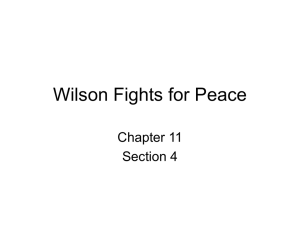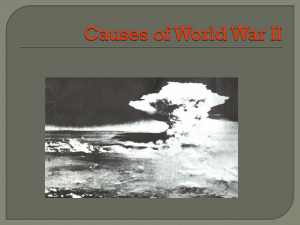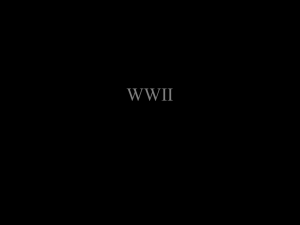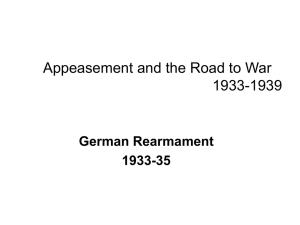Revision notes
advertisement
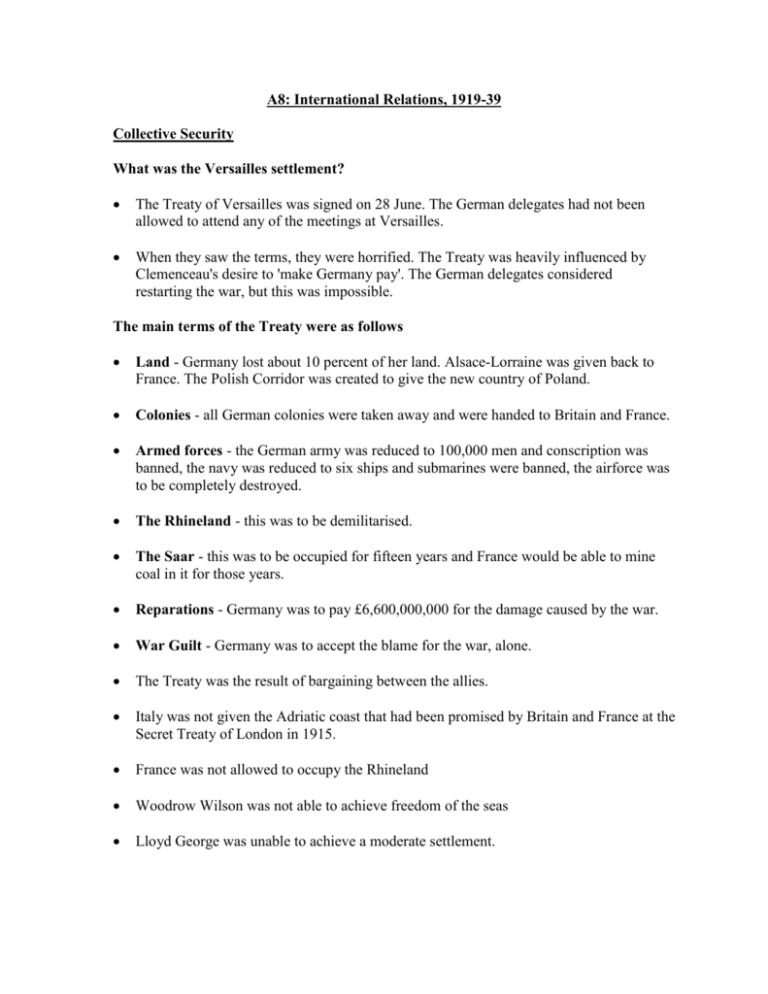
A8: International Relations, 1919-39 Collective Security What was the Versailles settlement? The Treaty of Versailles was signed on 28 June. The German delegates had not been allowed to attend any of the meetings at Versailles. When they saw the terms, they were horrified. The Treaty was heavily influenced by Clemenceau's desire to 'make Germany pay'. The German delegates considered restarting the war, but this was impossible. The main terms of the Treaty were as follows Land - Germany lost about 10 percent of her land. Alsace-Lorraine was given back to France. The Polish Corridor was created to give the new country of Poland. Colonies - all German colonies were taken away and were handed to Britain and France. Armed forces - the German army was reduced to 100,000 men and conscription was banned, the navy was reduced to six ships and submarines were banned, the airforce was to be completely destroyed. The Rhineland - this was to be demilitarised. The Saar - this was to be occupied for fifteen years and France would be able to mine coal in it for those years. Reparations - Germany was to pay £6,600,000,000 for the damage caused by the war. War Guilt - Germany was to accept the blame for the war, alone. The Treaty was the result of bargaining between the allies. Italy was not given the Adriatic coast that had been promised by Britain and France at the Secret Treaty of London in 1915. France was not allowed to occupy the Rhineland Woodrow Wilson was not able to achieve freedom of the seas Lloyd George was unable to achieve a moderate settlement. Why was the League of Nations founded? The League of Nations was the Fourteenth Point of Woodrow Wilson’s Fourteen Points. He was not so concerned with punishing Germany, but wanted to try to ensure that no wars took place in the future. The League was created because the war had been so horrific that the Allies wanted to try to prevent anything like it ever happening again. Membership of the League was open to all countries. But Germany was not allowed to join and nor was Russia. The Council met three times a year. There were four permanent members, Britain, France, Italy and Japan (Germany became the fifth in 1926). They took most of the important decisions. The Assembly had representatives of all the members and it meant once a year. The Covenant was the agreement which members had to sign. The Council of Ambassadors often took decisions, because the Council and Assembly only met occasionally. Economic Sanctions banned trade; Military Sanctions meant a declaration of war by each member. The Secretary-General was in charge of the administration of the League. The Secretariat was the civil service of the League, which was based in Geneva. Strengths and weaknesses of the League All of the leaders who signed the Covenant in 1919 had experienced the war and wanted to avoid any repetition. At the beginning there was a great deal of good will to make the League work. The idea of ‘Collective Security’ was also very sound. Russia was not allowed to join after the Bolshevik seizure of power in 1917. The USA did not join, even though the League was Woodrow Wilson's idea. Congress voted against membership. Americans believed that the United States would be drawn into internal conflicts in other countries. Most people in the United States wanted to concentrate on domestic issues. Germany was not allowed to join, but did become a member in 1926. Italy broke the Covenant in 1923 when Mussolini occupied Corfu, which was owned by Greece. He was forced to back down but no sanctions were applied. A Permanent Council Member had been allowed to escape when it had broken the Covenant. The League soon came to be seen as a club for the victors of the First World War and was mostly European. Sir Eric Drummond, the Secretary-General, was a representative of one of the Permanent Members of the Council and this made countries outside Europe believe that the League was pro-European. The League had no army; it had to rely on member countries declaring war on countries that broke the Covenant. What were the successes and failures of the League in the 1920s? The League itself was a success, as nothing like it had ever existed before. The League was successful in the 1920s in settling disputes between countries. Finland and Sweden argued over which country should own the Aaland Islands. The League settled the dispute in favour of Finland. When Greece and Bulgaria became involved in a border dispute, the League was called in to decide who was right. The League also did very good work in a campaign to stamp out the slave trade and in tackling diseases. In August 1923 five Italian surveyors were mapping the Greek-Albanian border for the League of Nations. They were shot and killed on the Greek side of the border and Mussolini, the Italian Prime Minister, demanded compensation from the Greeks. When the Greek government ignored the demand, Mussolini ordered the Italian navy to bombard and then occupy the Greek island of Corfu. Italy was also a Permanent Member of the Council of the League. Eventually the League backed Mussolini and forced the Greeks to pay compensation. Then Mussolini had to withdraw his forces from the island. The Corfu incident seemed to suggest that Permanent Members of the Council could get away with breaking the Covenant. It also suggested that while the League could deal effectively with small countries, it could not deal with large countries, Why Locarno and the Kellogg-Briand Pact important? During the 1920s the League was generally regarded as a success and the idea of Collective Security was widely accepted and the people of many countries took the League very seriously. In 1925 the Locarno Pacts were signed. France, Germany and Belgium agreed to respect each other’s borders and Britain and Italy signed the pacts as guarantors. There were also a series of agreements to settle border disputes between Germany, Poland and Czechoslolvakia. Germany was admitted to the League of Nations and became the fifth Permanent Member of the Council. In 1926 Frank Kellogg, the US Secretary of State, put forward a plan for the renunciation of war. The idea was taken up by Aristide Briand, the French Foreign Minister and became the Kellogg-Briand Pact. It was signed by most countries in Paris in August 1928. The League adopted the Pact the following month. Appeasement Why did Japan invade Manchuria in 1931? Japan had failed to gain the territory she was expecting at the Treaty and in the 1920s there was a revival of traditional Japanese ideas. In the 1920s the population of Japan also began to rise quickly and prices for rice and silk began to fall. The government decided that expansion was the best solution. In 1931 the Japanese army invaded Manchuria. It claimed that a railway had been blown up at Mukden on 18 September. In 1932 the Japanese set up the puppet state of Manchukuo, with the last emperor of China, P’u-i as its head. The League of Nations set up the Lytton Commission to investigate. It reported that there was no evidence that the Japanese had acted in self-defence and recommended that Manchuria should be an autonomous region under Chinese control. The Japanese ignored the report and the condemnation from the League and resigned in 1933. In July 1937 the Japanese army invaded northern China. The Japanese airforce was used to bomb Chinese cities into submission. Within a year Nanking, the capital, Tsingtao, Canton and Hankow had all been taken. The Japanese government began to demand that Britain and the other western countries should give up supporting China and co-operate with Japan in establishing a ‘new order’ in the Far East. Why did the Disarmament Conference fail? In February 1932 the League of Nations Disarmament Conference began at Geneva. Sixty countries took part, including the USA and the Soviet Union. The League wanted all countries to give up aggression. There were a number of different suggestions. The main reason for failure was that France and Germany could not agree. The French wanted to be certain that if they reduced the size of their armed forces that they would not be threatened by Germany. The Germans wanted the terms of the Treaty of Versailles, which restricted the size of their armed forces, abolished. Neither side would give way. After Hitler became Chancellor of Germany in January 1933, he refused to accept any reductions in armed forces and claimed that since Germany was already disarmed, the other countries should follow its lead. Hitler withdrew from the Disarmament Conference and also from the League of Nations in October 1933. Eighteen months later, in March 1935, Hitler announced that he was going to ignore the restrictions on the German armed forces that had been imposed at Versailles. The League condemned Hitler’s action, but did nothing about it. Why did Italy invade Abyssinia in 1935? Italy had tried to invade Abyssinia in 1895, but had suffered a humiliating defeat at the battle of Adowa. Mussolini also wanted to shift public opinion in Italy away from the failures of his domestic policies. In Italy he was becoming increasingly unpopular. On 3 October 1935, the Italian armed forces invaded the African state of Abyssinia (now called Ethiopia). In early 1936, Mussolini ordered the use of poison gas. In May 1936 the capital Addis Ababa was occupied and the Emperor Haile Selassie fled to Britain. Abyssinia was annexed by Italy and the King of Italy became Emperor of Abyssinia. Why was the invasion important? It created a crisis because Italy was a Permanent Member of the Council of the League of Nations. Sanctions were applied to Italy but Britain and France opposed the addition of oil, which would have been most effective. They did not want to offend Mussolini and drive him over to Hitler's side. Britain and France offered to arrange the Hoare-Laval Pact, which would have been a compromise. This would have given Mussolini control of most of Abyssinia. But when this became public it had to be dropped as a result of adverse opinion. All in all Britain and France, and the League of Nations, appeared to be weak and to be allowing Mussolini to get away with naked aggression. Although Mussolini did not resign from the League immediately, he did in 1937. There were now just two remaining Permanent Members of the Council, Britain and France. Hitler and the League In 1935 Hitler began rearmament. Conscription was reintroduced and the army, navy and airforce were all built up. The League protested but did nothing. The Anglo-German Naval Treaty was an agreement that allowed Germany to build a navy up to 35 percent the size of Britain's. This broke the terms of the Treaty of Versailles and encouraged Hitler to go even further. On 7 March 1936, Germany reoccupied the Rhineland. In fact Hitler had committed virtually his entire trained military forces to the reoccupation and the commanders carried sealed orders, which ordered them to retreat if opposed, but he got away with it. Hitler now set out to achieve the Anschluss, the union of Germany and Austria, which had been specifically banned by the Treaty of Versailles. Hitler had been born in the town of Braunau-am-Inn in the former Austro-Hungarian Empire. He was not technically a German citizen, even though he had lived in Germany since 1913. On March 1, unrest broke out in parts of Austria caused by Nazis. Soon the whole country was in chaos. On March 11, Hitler sent an ultimatum demanding the resignation of Schussnigg, the Austrian chancellor. German troops were massed on the border. On March 13, Austria and Germany were united. On April 10 a plebiscite was held which gave a 99.75 % majority in favour of Anschluss. Austria was immediately incorporated into the German Reich. The speed at which these events took place made reactions by Britain and France difficult. The two countries protested, but did little more. Why was there a crisis at Munich? It was obvious that Czechoslovakia would be Hitler’s next target. On 12 September 1938, Hitler demanded self-government for the German speaking Czechs in the Sudetenland. On 15 September Neville Chamberlain, the British prime minister, flew to meet Hitler at Berchtesgaden and agreed to his demands. The Czech government was informed of Chamberlain's decision. On 22 September Chamberlain returned to meet Hitler at Bad Godesberg. Hitler now had new demands. He wanted the Sudetenland to be handed over to Germany immediately. Chamberlain returned to London believing that war was inevitable. But Mussolini suggested a four power conference. Germany, Italy, Britain and France, met at Munich on 28 September 1938. They agreed to let Hitler have the Sudetenland. Hitler and Chamberlain signed an agreement that Britain and Germany would never go to war again. Hitler claimed that he had only been interested in uniting Germans. In March 1939 Hitler occupied the rest of Czechoslovakia. This was a clear violation of the Munich Agreement and showed that Hitler was not just aiming to unite all German speakers in a Greater Germany. Why did the British government adopt a policy of appeasement? Appeasement was the belief that the Dictators could be pacified if their demands were met. There was a strong view that the Treaty of Versailles had been too harsh and that, therefore, it was not unreasonable to allow Hitler to break some of the terms. Hitler was also admired by some people for the way that he had rebuilt Germany after 1933. People became more and more convinced that bombing would be highly dangerous. Bombers, high explosive and poison gas meant that the war would affect people in Britain far more than ever before. People remembered the horrors of the Great War. Why did war break out in September 1939? From March 1939 there could be no doubt that Hitler would have to be stopped one way or another. In April 1939 Britain made defensive alliances with Romania and Poland. These meant that if either country was attacked Britain would go to war to defend them. In August 1939 Germany and the USSR signed the Nazi-Soviet Pact. On the face of it this was a simple non-aggression pact between the two countries. There were a number of secret clauses. The Soviet Union agreed not to interfere when Germany attacked Poland and also would allow Hitler a free hand in western Europe. In return, Germany would allow the Soviet Union to occupy eastern Poland and would not interfere if Stalin occupied the Baltic States and Finland. On 25 August 1939 Britain signed a formal alliance with Poland. On 1 September 1939 Germany invaded Poland. On 2 September 1939, the British Government sent an ultimatum to Germany demanding that all forces should be withdrawn from Poland or war would be declared. This was ignored. On 3 September 1939 Britain declared war on Germany.
